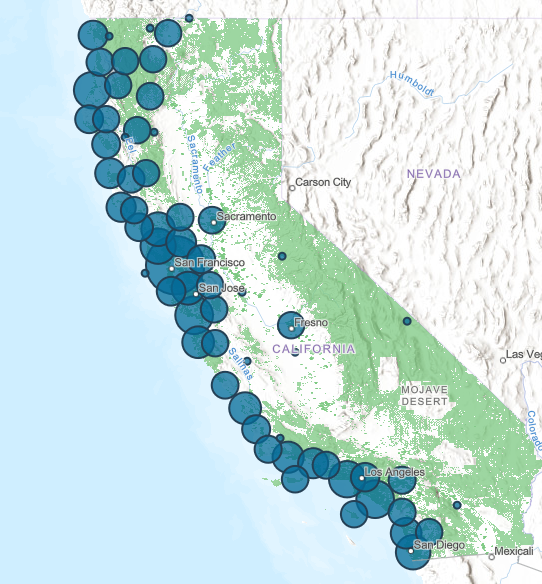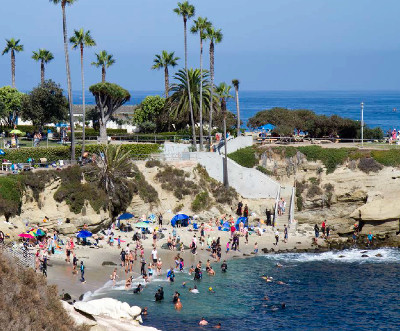South Coast
The California South Coast region extends from Ventura County to the Mexican Border and includes the counties of Los Angeles, Orange and San Diego. It is known for its sandy beaches, surf-able waves, moderate climate, and large and diverse population. The region is defined by the coastal plains of several major rivers and is bounded by the Transverse Mountain Ranges that include the Santa Monica and Santa Susana Mountains. The south coast of California has extremely high levels of species diversity, many of which are unique to the region, and the greatest number of threatened and endangered species in the state.
The beaches of the south coast are world famous recreational destinations that attract millions of visitors annually and are a major contributor to both the economy and the quality of life in the region. Southern California beaches typically receive over a million visitors each year.
Southern California is also home to about 24 million people. The two largest cities on the west coast, Los Angeles and San Diego, are located in southern California. This proximity of dense urban development and sensitive natural areas creates a unique set of issues for the Conservancy to address in this region.
South Coast Project Priorities
Expanding opportunities to access the coast and beaches, restoring coastal marshes, and providing parks and trails along rivers that connect to the coast are the key priorities for the South Coast Program. With the exception of Ventura County, the coastal areas LA, Orange and San Diego are extensively urban, so providing areas of respite for people and wildlife is critically important.
- Coastal Access — The Coastal Conservancy works with local government agencies to develop the Coastal Trail, provide beach wheelchairs and restrooms, and restore coastal piers. We are working on regional trails like the Santa Clara River Parkway, the Los Angeles River Trail, and the Santa Ana River Trail, which will connect to the Coastal Trail and provide links to inland communities. We are also working on ways to provide low cost overnight lodging such as hostels and campgrounds.
- Marshes — Much of the once vast complexes of coastal wetlands of Southern California have been destroyed. Through the Southern California Wetland Recovery Project, the Coastal Conservancy has been leading the effort to engage scientists and State and Federal agency representatives to identify priority restoration sites and approaches. The Regional Strategy Update will identify habitat goals for the region and is expected to be completed in 2017. The WRP covers the entire south coast region plus Santa Barbara County. Priority restoration projects include Ormond Beach, Ballona Wetlands, Los Cerritos in Long Beach, and the Tijuana River estuary.
- Nonpoint Source Water Pollution — Water in the rivers and along the coast of southern California is seriously impacted by urban runoff. Of special concern are the impacts to swimmers at the state’s popular beaches. The Conservancy has focused on urban greening projects in Los Angeles in particular, and has worked with the City to develop building standards for residential green streets to promote storm water infiltration through features like rain gardens and permeable pavement. We are working in South LA with the City and the Trust for Public Land to create a system of green alleys that will infiltrate and clean rain water, and with the Council for Watershed Health, Community Conservation Solutions, and others, to identify optimal locations for storm water infiltration throughout LA County.
- Climate Change Resilience — Many communities in the South Coast Region are vulnerable to flooding caused by sea level rise, and the Conservancy has been working to develop tools for local government to use to identify areas likely to be affected the most. The Coastal Storm Modeling System (CoSMoS) will be complete in the summer of 2016 and will model the areas throughout the region likely to be inundated during extreme events. We have also been working to implement “living shoreline” projects such as creating oyster beds in San Diego and Upper Newport bays, and restore sand dunes in Carlsbad. In addition to tidal wetlands, beaches, sand dunes and oyster reefs also offer protection from storm surge and reduce shoreline erosion. Other projects we have undertaken to help address climate change impacts include developing parks in heavily urbanized areas. These parks offer multiple benefits as they provide respite from higher temperatures, capture and infiltrate storm water, and provide wildlife habitat.
South Coast Projects
Click on the links below to find out more about the Coastal Conservancy’s work.
- Malibu Coastal Access Public Works Plan
- LA Urban Greening interactive map
- Ormond Beach Wetlands Restoration Project
- Ballona Wetlands Restoration Project
- Mapping the Historical Wetlands of the Southern California Coast
- Santa Clara River Parkway
- South San Diego Bay Wetlands Restoration Project
- Southern California Wetlands Recovery Project
- Southern California Wetlands Recovery Project Regional Strategy 2018
- West Coyote Hills
- Malibu Coastal Access Public Works Plan – If you are looking for information on the Malibu PWP please email Kara Kemmler
South Coast News
- Press Release: Coastal Conservancy Awards over $40 million for coastal access, restoration, and climate resilienceOakland, CA (4/18/2024) – Today, the Board of the State Coastal Conservancy approved grants totaling over $40 million for coastal access, restoration, and climate resilience. Among the grants awarded today are: A grant of up to $6,000,000 to Humboldt County Resource Conservation District to undertake the North Coast Wildfire Resilience Planning and Implementation Grant Program, which […] (Read more on Press Release: Coastal...)
- Coastal Conservancy Awards Grants for Coastal Access, Restoration, and Climate Resilience2/15/2024 – Today, the Board of the State Coastal Conservancy authorized a number of grants to restore, protect, and expand access to the California coast. Grants approved included: A grant of an amount not to exceed $35,000,000 to The Nature Conservancy to complete permitting and implement the first phase of the Ormond Beach Restoration Public Access […] (Read more on Coastal Conservancy Awards...)
- Press Release: State Coastal Conservancy Announces Awards for Coastal Resilience, Public Access, Restoration, and StorytellingSan Luis Obispo – This week, the California State Coastal Conservancy announced more than $39 million in funding for projects to improve public access, climate resilience, habitat values, and inclusion at the coast. “The Coastal Conservancy’s vision is of a beautiful, restored, and accessible coast for current and future Californians. To achieve this, we […] (Read more on Press Release: State...)

 Help Save Sea Otters at Tax Time
Help Save Sea Otters at Tax Time


